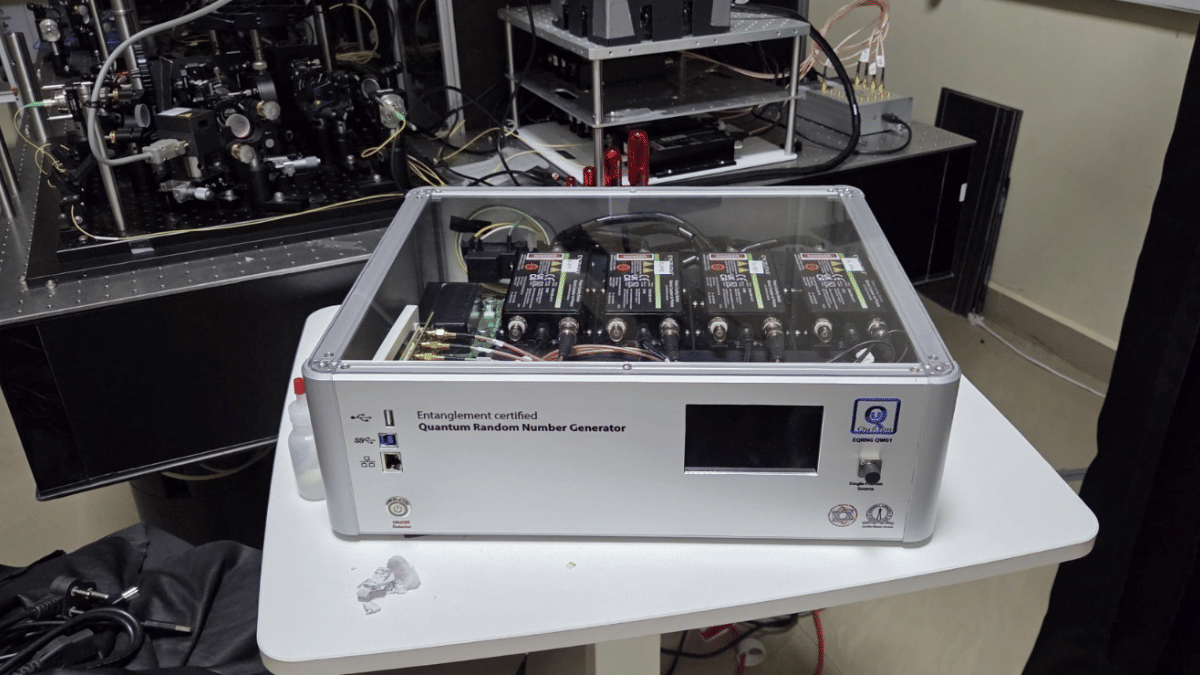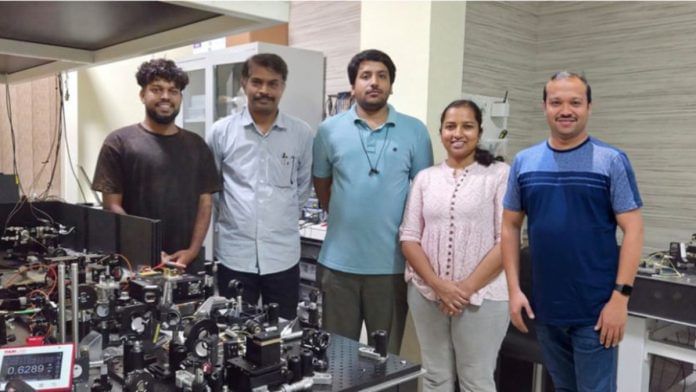Bengaluru: Scientists at the Indian Institute of Science (IISc) have built a six‑qubit photonic quantum system—the first-of-its-kind in the country—as part of the National Quantum Mission (NQM), a government programme to develop indigenous quantum‑technology capabilities.
Unlike normal computers that use a binary system operating with two states of 0s and 1s to store and process data, quantum computers rely on qubits, which follow the principle of “superposition”. The principle of superposition allows qubits to be in both states, 0 and 1, at the same time.
Superposition, along with quantum interference (when subatomic particles interact with and influence themselves and other particles while in a probabilistic superposition state) and entanglement (when two particles link together in a certain way no matter how far apart they are in space), gives quantum computers an extraordinary computing ability that is beyond ordinary computers.
Processing power and capacity of a quantum computer increases with the number of qubits (the basic unit of information used to encode data in quantum computing) it contains.
“What we have developed is a six-qubit photonic system,” Prof. C.M.Chandrashekar, head of IISc’s Quantum Optics and Quantum Information Processing Lab, told ThePrint.

Though the system may be small in number, it is the first demonstration in the world—according to Prof. Chandrashekar—where a six-qubit entangled GHZ (Greenberger–Horne–Zeilinger) state has been generated using the gate operations without any probabilistic process and by using only photons. This positions India among few nations which are capable of developing quantum computing using light-based particles.
The progress has come under the umbrella of the NQM, an initiative by the Centre’s Department of Science and Technology (DST) focused on developing indigenous quantum technologies.
Prof. Chandrashekar went on to explain the working of a quantum computer that uses ‘light packets’, or photons. “A packet of light simply means a photon. They are massless, electrically neutral particles that can be precisely controlled to store and process quantum information.”
The IISc team used different properties of photons as the building blocks of computation. The researchers demonstrated that it’s possible to perform deterministic quantum-gate operations, achieving what Prof. Chandrashekar refers to as “a practical way to make photons compute.”
The real challenge, he says, is scaling the system to larger qubit networks.
Bengaluru-based startup QpiAI has one of India’s most powerful quantum computers, equipped with 25 superconducting qubits.
Also Read: Should Karnataka elephants be kept in confinement camps? Everyone has a different view
First steps
For years, scientists have been working on the idea that the future of computers relies on quantum mechanics. In the 1980s, American physicist Richard Feynman explained that classical or ordinary computers cannot reproduce or handle systems that follow the principles governed by quantum mechanics.
In the 1990s, scientists like Peter Shor and Lov Grover came up with algorithms that proved how powerful quantum computers could be used in solving difficult problems.
The next challenge was to build quantum computers. Superconducting circuits, trapped ions, photons, and cold atoms are all potential contenders for qubits. IBM and Google are mainly focusing on superconducting circuits, but these systems are noisy when more qubits are added and require extremely cold environments to operate. Similarly, ion-trap systems, developed by companies like Honeywell (now Quantinuum), need sub-zero temperatures and they struggle with scalability.
As for photons, their biggest advantage is that they can be manipulated at room temperature. But making photons interact with each other is an extremely hard task, and this makes it difficult to carry out the multi-qubit gate operations needed for doing quantum computations.
Though laboratories around the world have only managed to achieve these operations in a probabilistic manner, there were still numerous questions and challenges. Now, building on international progress, scientists at IISc have found ways to perform deterministic quantum gate operations by utilising multiple degrees of freedom within a single photon.
Before this breakthrough, the IISc team faced challenges due to an unreliable method for executing deterministic two-qubit operations, which hindered the development of photonic qubit systems.
This was addressed by encoding qubits across different degrees of freedom within a single photon, allowing controlled interactions without chance, says Prof. Chandrashekar. “Things have to evolve systematically; you build the system qubit by qubit.”
The team developed a clean single-photon source and then entangled photons through their path degrees of freedom to create a two-qubit setup. Using this foundation, the group created an entanglement-based quantum random number generator (QRNG) capable of generating random bits at speeds exceeding 80 megabits per second. This, according to Prof. Chandrashekar, was the first plug-and-use device of its kind.
The IISc team then developed an integrated working device. Every component was custom built before they were combined into one compact unit. The device is neatly housed in a single box and operates successfully. Four units are already in use by government agencies to generate secure encryption keys.
Humble beginning
In 2020, with support from the Office of the Principal Scientific Adviser to the Government of India, Prof. Chandrashekar decided to shift from theory to experimentation while at the Indian Institute of Mathematical Sciences in Chennai. He moved to IISc Bengaluru to create a photonic quantum computing lab during the COVID-19 pandemic, a time he describes as “risky yet transformative”.
The team’s first goal was to turn mathematical models of quantum walks (the approach of photonic quantum walk) into a working experimental setup. As more students and researchers joined, the theory began to take shape. Within two years, they demonstrated functioning two-qubit systems. This was followed by a four-qubit photonic system, including an operational plug-and-use quantum random number generator, in the third year.
These successes gained the IISc team recognition as an official Technology Group on Photonic Qubits under the NQM, later becoming part of the Quantum Computing Hub at IISc. In 2024, they showed deterministic quantum teleportation in a three-qubit system, marking India’s first demonstration of quantum teleportation.
The US, China, and Canada are all actively pursuing photonic quantum computing. India’s involvement is relatively new, with Prof Chandrashekar acknowledging that the country is still behind in terms of pure numbers. “If we are to compete in qubit count, we are far behind.”
However, he believes that the way to compete is not by replicating existing methods but by taking innovative approaches. A Chinese research group demonstrated an 18-qubit entangled state using six photons, but they did not show the implementation of all universal quantum gates, he says.
“We may have fewer qubits, but we have demonstrated deterministically universal gate operations, and this difference is crucial. Our strength lies in developing systems that work with stability and clear logic rather than merely focusing on scale,” he says.
The team has already built two and four-qubit systems capable of generating quantum-secure keys for cybersecurity. Their four-qubit system can create public and private keys that encrypt both information and images. Such systems are beneficial for encryption, securing communications, and high-speed entanglement-certified random number generations, all crucial for national security and data protection.
Prof. Chandrashekar estimates that it will take at least another decade for India to develop a fully functional quantum computer capable of solving a significant number of problems demonstrating quantum advantage.
A balance must be struck between fostering research-focused human resources and advancing industry initiatives, says Prof. Chandrashekar. For India, any short-term differences may become negligible in the long run.
“We should not rush; instead, we need to steadily build our resources and focus on innovative technology,” the IISc professor adds.
Tejus RS is an alumnus of ThePrint School of Journalism.
(Edited by Tony Rai)
Also Read: This Tamil Nadu village doesn’t burst crackers on Diwali. Noise disturbs its divine birds






